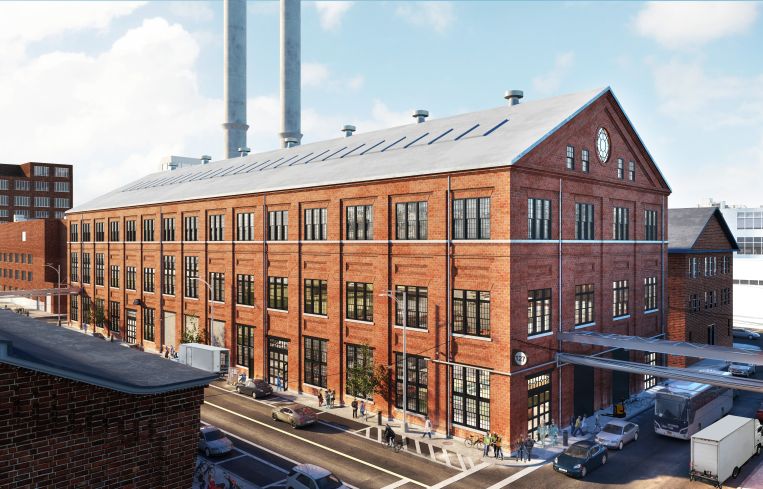Presented By: Future of Series presented by JPMorgan Chase
Using Historic Tax Credit Equity to Transform New York Commercial Real Estate
By Future of Series presented by JPMorgan Chase March 10, 2025 10:08 am
reprints
Partner Insights spoke to Melissa McCormack, executive director of Historic Tax Credit at JPMorganChase, about how the firm is helping developers tap federal Historic Tax Credit (HTC) equity to restore and repurpose historic buildings. McCormack is based in New York and brings a legacy of banking and preservation skills to every transaction.

Commercial Observer: Can you provide a brief overview of how the Historic Tax Credit works?
Melissa McCormack: Qualifying buildings are at least 50 years old, but there are also a few exceptions for newer buildings that are determined to be historically significant. These properties either (1) must be listed, or be determined likely to be listed, on the National Register of Historic Places, or (2) be a contributing structure to a registered “historic district.” Buildings that qualify for the program have to be income-producing properties. Personal residences don’t qualify.
Buildings can qualify for National Register listing based on their architectural significance, their association with a significant historical event, or their connection to a notable person. Additionally, buildings that are representative of a national ideal or way of life may also qualify. Many people assume that the only eligible buildings are elaborate Victorians from the 1800s or beautiful 1920s prewar structures. However, the 50-year rule means that post-modern structures built in the mid-1970s now also qualify.
It should be emphasized that the federal HTC is not a limited resource. It’s neither a competitive allocated credit, nor is the federal HTC program capped. Rather, if a building qualifies as being historic and the plan of substantial rehabilitation is approved by the National Park Service, then such rehabilitation is eligible for HTC.
How is the credit allocation calculated?
The cost of the components used to restore or adaptively reuse a historic property are the basis for calculating the amount of the HTC available for a rehabilitation. Acquisition costs, building enlargement, site work and similar costs not associated with the historic building itself are not eligible. These eligible costs for exterior and interior construction costs are commonly referred to as qualified rehabilitation expenditures or QREs.
Typically the amount of QREs is approximately 80 percent of the hard and soft costs of the total development and construction budget, excluding acquisition costs. The amount of HTC available to a rehabilitation equals 20 percent of such QREs.
The property owner can allocate the HTC among its partners, which can include third-party investors such as JPMorganChase. Another commonly used structure is the lease pass-through structure, whereby the property owner elects to pass-through the HTC to a long-term tenant of the property. That long-term tenant usually admits a third-party investor and allocates the HTC among its partners. In either case, the third-party investors effectively provide low-cost capital to offset the cost of the QREs.
Can you talk about how Historic Tax Credit at the federal, state and local levels can be used to help a development deal pencil out?
In many cases, the federal HTC program is augmented by a corresponding state HTC program. New York State offers a credit that we frequently use for projects in the city and Upstate as well. The New York State HTC operates very similarly with the federal HTC, though the New York State HTC is capped at $5 million per building.
For multiple sites and buildings upstate, smaller projects often use the additional financing to strengthen their operating budget, so they can lessen the burden of the mortgage financing.
HTC is often used as part of the capital stack in preserving affordable housing apartment complexes or campuses where there are multiple buildings. HTC can make a huge impact by reducing the amount of subsidy required from local municipalities to move these types of impactful affordable housing projects across the finish line.
How does Historic Tax Credit fit into the capital stack of real estate development projects?
In the current market, HTC typically results in an equity investment equal to approximately 15 percent of the overall capital stack, excluding acquisition costs. That HTC equity is typically paid over time, with installments from HTC investor upon (1) its admission as a partner before or during construction, (2) construction completion, (3) receipt of approvals from National Park Service and (4) attainment of stabilized operations.
Can Historic Tax Credit be used in conjunction with other types of credit?
Absolutely, yes. We often collaborate with our colleagues in our New Markets Tax Credit (NMTC) group. Those projects typically are focused on high-impact nonresidential projects that provide community services or job opportunities to underserved communities. When we work with them, it tends to be an adaptive reuse of a historic building for a slightly different profile of project like charter schools, performing art venues, and community centers. These are all income-producing, nonresidential properties.
We also work with Solar Investment Tax Credit, a growing trend among historic buildings. Increasingly, we see projects incorporating solar panels.
HTC can also be used with Low-Income Housing Tax Credit (LIHTC) to help create and preserve affordable housing around the country.
How does tapping Historic Tax Credit aid in influencing environmental concerns?
It’s often said that adaptive reuse of a building, rather than demolition and new construction, is green construction. There’s also a cultural benefit for retaining these assets in the community. Reusing an existing building has additional benefits that are often overlooked, such as conserving materials from a teardown that would otherwise end up in landfills. That practice significantly reduces environmental impact.
Adaptive reuse also cuts down on the carbon footprint of real estate development by minimizing the need for new construction materials and the associated shipping to the project site.
A lot of older buildings, especially the ones constructed before mid-century, had very desirable inherent design features. We see a lot of natural lighting, high ceilings and cross-ventilation already built in.
What is the supply of historic buildings in New York that might qualify for a Historic Tax Credit, and what type of asset classes are they?
All asset classes are eligible for the Historic Tax Credit program provided that they will be used as an income-producing property.
The most common assets classes for adaptive reuse projects tend to be multifamily residential, mixed-use retail, and sometimes hotels/hospitality. We have completed a few projects in New York focused on light manufacturing, such as the Brooklyn Navy Yard.
In upstate New York we see rehabilitations of old school buildings, warehouses and mills. These kinds of structures are often converted to multifamily rental communities or light industrial, a process that would be impossible or highly burdened without the HTC component.
In New York City, most of the projects involve renovating and converting buildings into much-needed affordable housing. The HTC can also be used to recapitalize existing affordable apartments that need improvements.
Are there any examples of building conversions you can point to in the state of New York that are especially successful?
We have a project in the Brooklyn Navy Yard, Building 127, which is a conversion of 100,000 square feet of heavy manufacturing, transformed into a mixed-use project that includes office and light manufacturing space.
We’re also working with the Permanent Affordability Commitment Together (PACT) program which is a public-private partnership between NYCHA and private developers who help retain the property as affordable housing by updating it and giving it a whole new life.
The EJ Victory building is a redevelopment of a previous shoe factory converted to mixed-use with office and apartments in the growing city of Johnson City, New York. We’ve also leveraged the housing authority redevelopment model that we’ve used on NYCHA for other redevelopment projects in Troy, New York.
Who is the best point of contact to receive more information about the Historic Tax Credit program and how JPMorganChase can assist?
Developers, building owners and government officials interested in exploring how Historic Tax Credit can be used to transform older buildings and communities should reach out to me at m.mccormack@chase.com.



